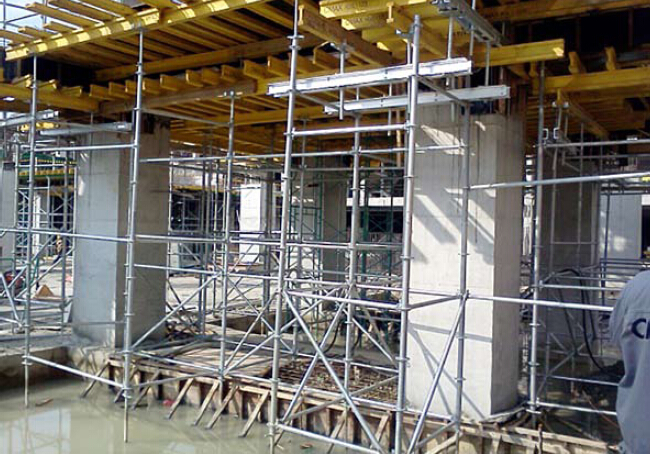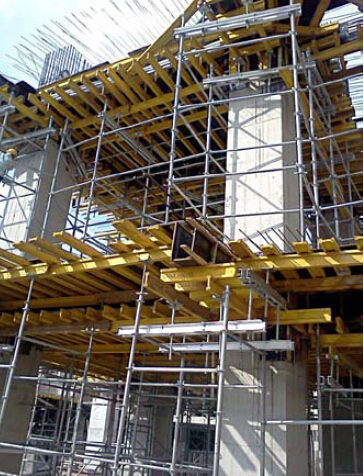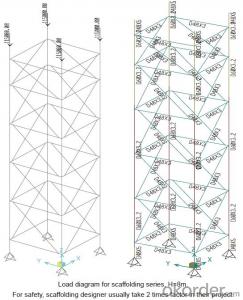Ring-lock scaffolding accessories for formwork and scaffolding system
- Loading Port:
- Tianjin
- Payment Terms:
- TT OR LC
- Min Order Qty:
- 50 m²
- Supply Capability:
- 1000 m²/month
OKorder Service Pledge
Quality Product, Order Online Tracking, Timely Delivery
OKorder Financial Service
Credit Rating, Credit Services, Credit Purchasing
You Might Also Like
Ring-lock Scaffolding
A support system for construction, ownsadvantages of both cup-lock scaffolding andshoring tower.
It is in the development direction of new typescaffolding.
It is widely used in buildings, bridges, tunnels etc..
Characteristics:
◆ Easy to storage and transportation
◆ High degree of standardization
◆ Easy and quick erection
◆ Excellent stability and bearing capacity


- Q:How does steel formwork compare to plastic formwork?
- Construction projects commonly utilize two types of formwork systems: steel formwork and plastic formwork. These systems possess distinct advantages and disadvantages, making them suitable for varying applications. Steel formwork is renowned for its durability and strength, enabling it to withstand heavy loads. Consequently, it is ideal for large-scale projects that necessitate repetitive formwork usage. Compared to plastic formwork, steel formwork boasts a lengthier lifespan, rendering it a cost-effective choice in the long term. It can be effortlessly tailored to meet specific project requirements, thereby permitting design flexibility. Moreover, steel formwork yields a smooth concrete surface finish, reducing the need for supplementary finishing work. Conversely, plastic formwork surpasses steel formwork in several aspects. Its lightweight nature facilitates easy handling and transportation, leading to expedited installation and dismantling times, thereby enhancing overall project efficiency. Plastic formwork is also corrosion-resistant and does not necessitate surface treatment or maintenance. Being reusable and recyclable, it embodies an environmentally friendly option. Furthermore, it possesses commendable insulation properties, thereby facilitating energy consumption reduction in buildings. Regarding cost, steel formwork generally incurs higher upfront expenses due to elevated material and manufacturing costs. Nevertheless, the prolonged lifespan and reusability of steel formwork offset the initial expenditure, rendering it a cost-effective decision for projects involving substantial concrete pouring. In conclusion, the selection between steel formwork and plastic formwork hinges upon specific project requisites. Steel formwork proves suitable for large-scale ventures necessitating durability and strength, whereas plastic formwork is more apt for smaller projects mandating swift installation and dismantling. Both alternatives possess their own merits and demerits, necessitating careful consideration of factors such as cost, project timeline, and design flexibility when arriving at a decision.
- Q:How does steel formwork affect the aesthetics of a building?
- Steel formwork can significantly impact the aesthetics of a building in several ways. Firstly, steel formwork allows for complex and intricate designs to be created, resulting in visually appealing architectural elements. The flexibility and strength of steel allow for the construction of unique shapes, curves, and patterns that enhance the overall aesthetics of the building. Additionally, steel formwork provides a smooth and seamless finish to the concrete surfaces. This smooth finish contributes to a more refined and polished look, especially when compared to other types of formwork such as timber or plastic. The absence of visible joints, seams, or imperfections on the concrete surfaces enhances the overall appearance of the building. Moreover, steel formwork can be reused multiple times, resulting in cost savings and reduced waste. This economic advantage allows architects and designers to allocate more resources towards enhancing the aesthetics of the building, such as incorporating high-end finishes or unique decorative elements. Furthermore, steel formwork provides a high level of accuracy and precision during the construction process. This precision ensures that the final structure is aligned and symmetrical, enhancing the overall visual harmony of the building. Straight lines, sharp corners, and consistent dimensions can be achieved through the use of steel formwork, resulting in a visually pleasing and harmonious architectural design. Lastly, the durability and strength of steel formwork contribute to the longevity of the building's aesthetics. Steel formwork can withstand harsh weather conditions, resist corrosion, and maintain its structural integrity over time. This durability ensures that the building's aesthetics remain intact for an extended period, enhancing its overall appeal and value. In conclusion, steel formwork positively influences the aesthetics of a building by enabling complex designs, providing a smooth finish, allowing for precision and accuracy, offering cost savings, and ensuring long-lasting visual appeal.
- Q:Can steel formwork be used for concrete beams with varying cross-sections?
- Certainly, concrete beams with varying cross-sections can be constructed using steel formwork. The versatility of steel formwork allows for easy adjustment and customization to accommodate different shapes and sizes of concrete beams. This flexibility in formwork design enables the creation of intricate and irregular shapes. Moreover, steel formwork exhibits exceptional strength and durability, making it well-suited for supporting the weight and pressure exerted by concrete during the pouring and curing stages. In conclusion, steel formwork is an excellent option for constructing concrete beams with varying cross-sections, offering adaptability, strength, and reliability.
- Q:How does steel formwork affect the construction schedule?
- The construction schedule can be significantly impacted by steel formwork. One of the main benefits of using steel formwork is its ability to provide a high level of stability and strength, enabling faster construction processes. This results in reduced overall construction time compared to traditional formwork methods. Moreover, steel formwork is highly durable and can be used multiple times, making it suitable for future projects. This reduces the time and cost associated with acquiring and assembling new formwork for each project, further enhancing the efficiency of the construction schedule. In addition, steel formwork allows for precise and accurate construction, resulting in a higher quality finished product. This minimizes the need for rework and corrections, ultimately saving time and ensuring that the project stays on schedule. Furthermore, steel formwork is known for its flexibility and adaptability. It can be easily adjusted and modified to accommodate design or construction changes. This promotes a smoother workflow and minimizes delays that may arise from design alterations. However, it is important to note that the initial setup and installation of steel formwork may require more time and resources compared to other formwork systems. The design and fabrication process for steel formwork can be more complex, necessitating careful planning and coordination. Therefore, it is crucial to consider these factors during the project planning phase to ensure that the construction schedule is not negatively affected. Overall, steel formwork can significantly expedite the construction schedule by offering strength, durability, precision, and adaptability. However, it is essential to thoroughly evaluate project requirements and available resources to optimize the use of steel formwork and minimize potential disruptions to the construction schedule.
- Q:How does steel formwork affect the overall construction site waste recycling?
- Steel formwork can have a significant impact on the overall construction site waste recycling. Unlike traditional timber formwork, steel formwork is more durable and can be reused multiple times. This reduces the amount of waste generated on the construction site as there is less need for new formwork materials to be produced and disposed of. Steel formwork is also easier to clean and maintain, further extending its lifespan and reducing the need for replacement. This not only reduces waste but also saves costs associated with purchasing new formwork materials for each construction project. Additionally, steel formwork is highly recyclable. At the end of its life cycle, steel formwork can be recycled and used to produce new steel products, reducing the demand for virgin materials and minimizing the environmental impact. By using steel formwork, construction sites can significantly reduce their waste generation and contribute to a more sustainable construction industry. This not only benefits the environment but also promotes a more efficient and cost-effective approach to construction.
- Q:How does steel formwork contribute to the overall safety of workers?
- There are several ways in which steel formwork contributes to the overall safety of workers. Firstly, its strength and durability provide a stable and secure structure for workers to perform their tasks, minimizing the risk of accidents and collapses. In addition, steel formwork is fire-resistant, offering protection in case of fire emergencies. This feature significantly reduces the risk of injuries and gives workers valuable time to safely evacuate the area. Furthermore, steel formwork is designed to withstand various weather conditions, such as strong winds and heavy rains. This resistance prevents instability or collapse during adverse weather, minimizing the risk of accidents and injuries for workers on-site. Moreover, steel formwork includes safety features like non-slip surfaces and handrails, which enhance worker safety by providing better grip and stability when moving around the structure. These features help prevent common accidents like slips, trips, and falls on construction sites. Another important aspect is that steel formwork is reusable and easy to assemble and disassemble. This reduces the need for workers to carry heavy materials or tools, decreasing the risk of strain injuries and fatigue-related accidents. Lastly, steel formwork is designed to ensure proper support and alignment during concrete pouring, minimizing the risk of structural failures or collapses. This precise alignment guarantees the stability of the structure and reduces the likelihood of accidents that could endanger workers' safety. In conclusion, steel formwork is crucial for enhancing the overall safety of workers. Its strength, durability, fire resistance, weather resistance, non-slip surfaces, and proper support significantly contribute to creating a secure working environment and reducing the risk of accidents, injuries, and structural failures.
- Q:Can steel formwork be used for projects with limited formwork stripping time?
- Projects with limited formwork stripping time can utilize steel formwork. Steel formwork is renowned for its durability and strength, rendering it suitable for diverse construction ventures. Unlike traditional formwork materials like wood or plywood, steel formwork can withstand higher pressures and loadings, enabling faster construction cycles. High-rise buildings, bridges, and infrastructure projects often employ steel formwork due to its time-sensitive nature. Its inflexible structure facilitates swift assembly and disassembly, minimizing formwork stripping time. Moreover, steel formwork can be reused multiple times, further diminishing construction time and expenses. Additionally, steel formwork guarantees precise dimensional control, ensuring accurate and consistent outcomes. This quality holds particular significance for projects with limited formwork stripping time since any errors or discrepancies in the formwork can result in delays and additional work. Nevertheless, it is essential to acknowledge that installing and removing steel formwork may require skilled labor and specialized equipment. Hence, meticulous planning and coordination are imperative to ensure efficient and safe utilization of steel formwork for projects with limited formwork stripping time.
- Q:What are the different safety features incorporated in steel formwork systems?
- Some common safety features incorporated in steel formwork systems include sturdy and durable construction materials, non-slip surfaces, guardrails and handrails for secure movement, proper anchoring mechanisms to prevent collapse, and clear signage to indicate potential hazards and safety precautions. Additionally, some systems may also have built-in fall protection systems or safety harness attachment points for added worker safety.
- Q:Can steel formwork be easily repaired in case of damage?
- In case of damage, steel formwork can be repaired with ease. Steel, being a highly durable and robust material, can undergo simple techniques like grinding or welding to fix minor damages such as dents or scratches. Moreover, if any major damages occur, necessitating the replacement of certain parts, steel formwork allows for effortless disassembly and reassembly, making it a practical choice for repair work. The adaptability of steel formwork ensures prompt repairs, thereby reducing downtime and associated costs.
- Q:What are the common design considerations for steel formwork?
- When considering the design of steel formwork, several factors need to be taken into account to ensure its efficiency and effectiveness. Firstly, the load-bearing capacity of the steel formwork should be carefully calculated and designed. The formwork needs to be able to support the weight of the fresh concrete and any additional loads, such as workers or equipment, without any deformation or failure. This requires evaluating the maximum expected load and selecting the appropriate steel grade and thickness. Secondly, the formwork should be designed to be easily assembled and disassembled. This is particularly important for projects with tight schedules or limited space. The formwork should consist of modular components that can be quickly and accurately connected, allowing for efficient construction and easy removal after the concrete has cured. Thirdly, the formwork design should take into consideration the desired surface finish of the concrete. If a smooth surface is desired, the formwork needs to be properly aligned and leveled to ensure an even and consistent concrete finish. Additionally, the formwork should be designed to prevent any leakage or seepage of the concrete, which could lead to surface imperfections or structural issues. Another important consideration is the stability and rigidity of the formwork. Steel formwork must be able to withstand the lateral pressure exerted by the fresh concrete without any significant deformation or displacement. Proper bracing and tie systems should be incorporated into the design to ensure the formwork remains stable during the concrete pouring process. Additionally, safety should be a top priority in the design of steel formwork. The formwork should be designed to provide a safe working environment for the construction workers, with adequate access, guardrails, and fall protection systems. The formwork design should also consider the ease of installation and removal of safety features, such as scaffolding or temporary platforms. Lastly, the formwork design should take into account the reusability and durability of the steel components. Steel formwork is often used in multiple projects, so it should be designed to withstand repeated use and be resistant to corrosion or wear. Proper maintenance and storage considerations should also be incorporated into the design to prolong the lifespan of the formwork. In conclusion, the common design considerations for steel formwork include load-bearing capacity, ease of assembly and disassembly, surface finish requirements, stability and rigidity, safety, reusability, and durability. By carefully considering these factors, a well-designed steel formwork can contribute to the successful and efficient construction of concrete structures.
1. Manufacturer Overview |
|
|---|---|
| Location | |
| Year Established | |
| Annual Output Value | |
| Main Markets | |
| Company Certifications | |
2. Manufacturer Certificates |
|
|---|---|
| a) Certification Name | |
| Range | |
| Reference | |
| Validity Period | |
3. Manufacturer Capability |
|
|---|---|
| a)Trade Capacity | |
| Nearest Port | |
| Export Percentage | |
| No.of Employees in Trade Department | |
| Language Spoken: | |
| b)Factory Information | |
| Factory Size: | |
| No. of Production Lines | |
| Contract Manufacturing | |
| Product Price Range | |
Send your message to us
Ring-lock scaffolding accessories for formwork and scaffolding system
- Loading Port:
- Tianjin
- Payment Terms:
- TT OR LC
- Min Order Qty:
- 50 m²
- Supply Capability:
- 1000 m²/month
OKorder Service Pledge
Quality Product, Order Online Tracking, Timely Delivery
OKorder Financial Service
Credit Rating, Credit Services, Credit Purchasing
Similar products
New products
Hot products
Hot Searches
Related keywords























